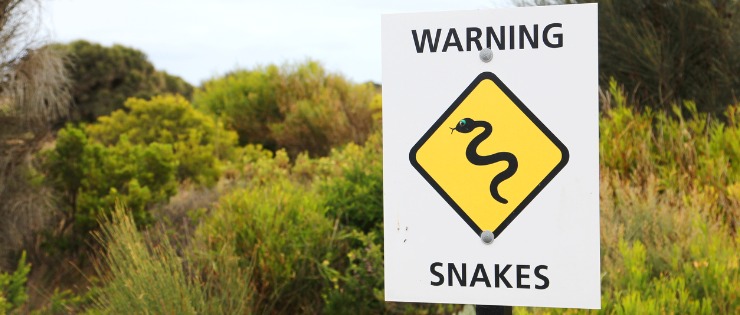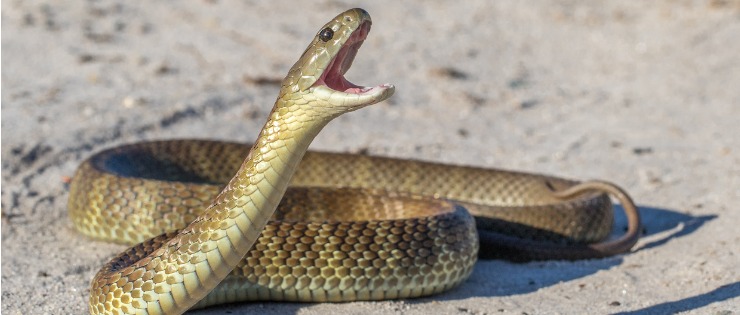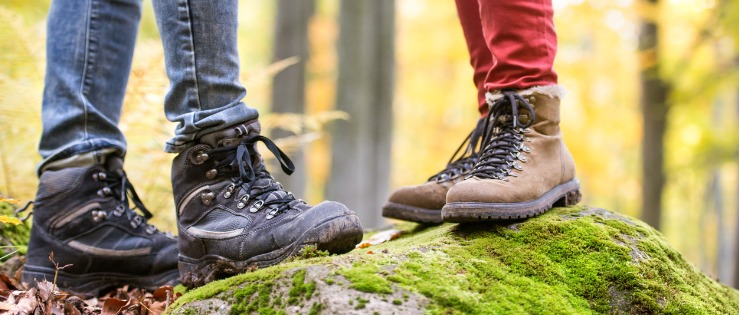
Australia is home to the 10 deadliest animals in the world, and most of them are snakes. You don’t need to venture into dense bush to be at risk of a snake bite. Thousands of suburban homes near sand dunes, bush reserves, and lakes report unwanted slithering visitors in their yards. More than half of the snake bite deaths between 2000 and 2016 occurred in and around the home.
Every Australian should know how to treat a snake bite and have access to a snake bite first aid kit. Some first aid knowledge and basic equipment can ensure you survive a bite. There are approximately 550 snake bites across the country each year and on average two people die from the snake bites. Snakes use their venom to stun, numb and kill other animals.
Snake Bite First Aid Kits
Carrying a snake bite kit is the best insurance policy for surviving a bite from a venomous snake. Buy a kit that you can easily take in your backpack or on your belt while out walking. Kits are compact and lightweight, so they aren’t a burden to carry.
Most snake bite first aid kits contents include at least:
• Two large width bandages
• Thermal reflective blanket
• Marker pen
• Treatment of a snake bite information sheet
First Aid for Snake Bite Victims

Follow these steps to assist someone who has been bitten by a snake:
Check the danger has gone and the snake will bite no one else
Sit the patient down and reassure them
Call for an ambulance
Take a wide elasticised bandage around 10-15 cm wide and bandage over the wound as soon as possible. Use another bandage and wind around the limb firmly, overlapping the bandage 10-15 mm each round. Bandage the entire length of the limb and tuck in any excess dressing. See How to Apply a Snake Bite Compression Bandage below for more information.
Use the marker to place a cross on the bandage to indicate the site of the bite.
To keep the limb immobilised, use whatever you can find such as a stick or rolled newspaper to make splints. Attach the splints to either side of the limb including joints and bandage.
Rest the arm on a surface and remind the patient not to move it.
Keep reassuring the patient that help is on the way.
Wrap the reflective blanket over the patient if they are in shock or cold.
Be prepared to begin CPR if the patient stops breathing.
Do not remove the bandage until the patient has arrived at a hospital.
Around 90% of all snake bites occur on a limb. If the bite is on the hand or arm, leave the fingers exposed when bandaging to check on the colour and circulation. If the bite is on the foot or leg, keep the toes exposed when bandaging. You shouldn’t be able to slip a finger under the bandage easily; it should be tighter than this.
Once the bandaging has been completed, keep the victim immobilised at all times. Ensure the limb is left as still as possible and the patient remains seated. The help has to come to them; they can’t walk; otherwise, the bandage can't do its job. Once the victim begins to move, their lymphatic system starts working, and the venom circulates through the body.
How to Apply a Snake Bite Compression Bandage
Applying a compression bandage is the most critical step in providing first aid to snake bite victims. The Pressure Immobilisation Technique (PIT) was developed by the Australian Resuscitation Council to treat bites and stings from snakes, funnel web spiders, blue-ringed octopus and cone shell.
Apply an elasticised bandage (10-15cm wide) over the bite site as soon as possible. Make sure it is tight that a finger can’t be easily slipped under the bandage. Elasticised bandages are better than crepe bandages. If bandages aren’t available, use clothing or material.
To keep the limb immobilised and to restrict lymphatic flow, apply another pressure bandage from the extremity as far up the limb as possible. Apply the dressing over any existing clothing. Attach a splint to both sides of the leg or arm.
If only one bandage is available, apply it as a pressure and immobilisation bandage to the full length of the limb.
This video shows you how to use a snakebite kit and apply a bandage correctly:
What Not to Do After a Snake Bite
It’s just as important to know what not to do after a snake bite.
Try not to panic – the faster your heart beats, the quicker the lymphatic system moves venom around the body
Don’t run – try to stay as still as possible
Don’t Cut the wound – years ago people would cut the area of a snake bite and try to suck out the venom. This is not recommended, always bandage and immobilise.
Don’t Apply a Tourniquet – a wide bandage rather than a tourniquet is recommend
Don’t try to Catch the Snake – take a photo or leave it to the medical staff to identify
Who is Most at Risk of Snake Bites?
Everyone is at risk of a snake bite, but more victims are middle-aged males than any other category. Of the 35 fatalities recorded in the 16 years to 2015, almost three-quarters of the victims were male. More than 20% of fatal attacks occurred when the victim was trying to pick up or kill a snake.
Half of the fatalities occurred within a major city or inner regional area, so city dwellers are at as much risk as those people living in the bush.
Types of Snake Bites
Not all snake bites are venomous bites where the snake release venom. Some are dry bites where the snake doesn’t release any poison. A snake catcher assumed his bite was dry and didn’t attend hospital until a friend insisted. A hospital test revealed toxins from snake venom in his system. Within eight hours of the bite, his kidneys were shutting down.
A dry bite can still be painful and cause swelling and redness, and a venomous bite can go unnoticed. It is essential to treat all bites as venomous and get medical attention to assess whether anti-venom is needed.
Symptoms of Venomous Snake Bites
Snake bite victims will typically show one or more of these signs of venom poisoning before they reach medical attention:
- Swelling, bleeding and bruising around the site
- Severe pain at the time of the bite or later
- Puncture marks or tiny scratches on the skin
- Anaphylactic shock within minutes of a bite
- Tingling or stinging feeling of the skin
- Nausea or vomiting
- Dizziness
- Blurred vision
- Swollen or sore glands nearest the bitten limb
- Difficulties breathing
- Irregular heartbeat
- Stomach pain
- Muscle weakness
- Confusion
- Collapse
- Paralysis
- Coma
Risk of Snake Bites in Australia
There are approximately 3,000 snake bites in Australia each year with 500 of those requiring hospitalisation. The severity of the symptoms depends on the type of snake.
The eastern brown snake, found throughout Australia, is highly venomous and was responsible for 65% of deaths between 2000 and 2016. They are an urbanised snake, so they are often found in and around homes. There are six species of brown snake including the dugite, found in WA.
Other venomous Australian land snakes include the taipan, tiger, red-bellied black snake and death adder.
The taipan is found between Darwin and Brisbane in non-desert areas. It’s aggressive with a high venom output which is almost certainly fatal if not treated.
The tiger snake prefers the more temperate climate of the south-west areas of Australia. It has a mortality rate of 45% for untreated bites.

The red-bellied black snake is found in on the east coast, and while its venom can make you very ill, there have been no recorded deaths.
The death adder is found all over mainland Australia. Due to the slow onset of symptoms, anti-venom can successfully treat their bite, but in the years before treatment was available, it had a 50% mortality rate.
Identifying the Snake
Do not try to kill a snake for identification purposes. The medical team will use a venom detection kit to find out if any venom is present and what type. Therefore, it is important not to wash the skin or discard any clothing that may have come in contact with the snake. If the snake can’t be identified (because the area was cleaned), a generic polyvalent anti-venom can be used.
How Much Time Do You Have to Get Anti-Venom?
Most snake bite victims can go without anti-venom for four hours if compression bandages and immobilisation is used. Due to their location, some victims have arrived at the hospital as late as eight hours after a bite from a taipan or brown snake still showing no symptoms. The bandages were successful in slowing the lymphatic fluid to a standstill, so the venom didn't circulate the body.
The most venomous brown snake, however, can cause a patient to deteriorate within five minutes of the bite and die within 30 minutes without treatment caused by cardiac depression.
Fatalities occur when neurotoxins, myotoxins and coagulants attack the nervous system, muscles and cause organ failure, cardiac arrest and cerebral haemorrhage. The 35 deaths to 2016 occurred between 1 and 19 days after the bite.
A Tale of Snake Bite Survival
In 2018 a WA man was lucky to survive a snake bite by a deadly brown snake. Christian Wright was walking in thongs while visiting the Dales gorge at Karijini National Park when he felt a prick on his foot, similar to a bee sting. He noticed a juvenile brown snake nearby but didn’t think the snake had bitten him.
Christian and his friend continued climbing down into the gorge. Fifteen minutes later he noticed he had a frontal headache and after his chest tightened. Being a nurse, he realised his symptoms were a snake bite before passing out. Christian drifted in and out of consciousness but was able to instruct the tourists how to apply a compression bandage. Other symptoms included pain, shaking, sweating and vomiting.
A ranger arrived soon after and mobilised 20 tourists to help carry him out on a stretcher and reached an ambulance an hour after the bite. Christian was taken to Tom Price hospital where doctors confirmed it was a brown snake and administered life-saving anti-venom.
How to Reduce your Risk of Snake Bite
There are five things you can do to protect yourself from a snake bite:
1. Wear Long Pants and Shoes
One-third of the fatal bites were on the foot or ankle and could have been preventable if the victim was wearing closed-in shoes. The brown snake has small 3mm fangs.

2. Be More Vigilant in Warm Weather
The majority of snake bites occur during the warmer months of October to May when snakes are most active. Be vigilant for snakes by looking where you walk although many snakes are well camouflaged and difficult to see.
3. Call in a Snake Catcher
Don’t try to catch a snake if you haven’t had training. Leave it to the experts to remove a snake if you find one in your home.
4. Stick to Walk Trails
Try not to walk through long grass, stay on cleared trails, if suitable. If you are bushwalking during summer, alert snakes by making some noise while you are walking.
5. Look out Where you Rest
Don’t put your hands into dark crevices, log hollows or grass where you can’t see if a snake is hiding. When you stop walking for a rest look around rocks and trees, anywhere snakes may be hiding.
More Information
Unfortunately, some snake bites are entirely unavoidable. You can take all the preventative measures possible, and a snake can still bite you. But you can be prepared with a snake bite first aid kit and training.
St John Ambulance Australia has a Bites and Stings Quick Guide which you can print and keep with you. This Snake Bite First Aid Poster is also available. How to Perform CPR will give you information on resuscitation if a snake bite victim stops breathing.
Always call 000 for an ambulance if you suspect someone has been bitten by a snake. Don't forget your ambulance cover just in case you do find yourself in an emergency.